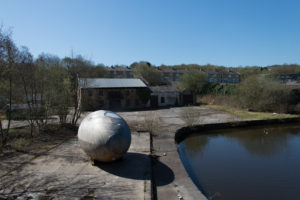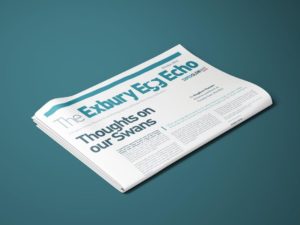The Exbury Egg was the focus of a Super Slow Way Residency at Finsley Gate Wharf, in which artist, Stephen Turner, worked in collaboration with Burnley Wood Community Centre from April to October 2016. It arrived in the spring of 2016, occupying and opening up a site beside the canal that had been gated, and closed for public access for thirty years. The space, an opening by the canal bank with empty buildings, included an old forge. It was overgrown and strewn with debris when The Egg arrived and for some time had offered an undisturbed habitat for birds and insects.
“Before I came, there had been no access to it (it had been closed by [British Waterways since 1986). I open it to visitors for an hour a day. I invite people in to talk about life in Burnley Wood. It’s very local – maybe the surrounding 15 streets. I invite people in for tea and chat … I’m using the concept of the Egg as a conversation piece. I’m quite interested in what makes a home for people and other animals who live around and how people live together – or don’t.” (Stephen Turner)
The Egg is described as a temporary, energy efficient, self-sustaining work space and for the duration of this six-month residency it became the base for an exploration of the canal bank and its fauna and flora. It also provided a social gathering point for people from the neighbourhood and a stimulus among its visitors for drawing, photography, creative writing. There were events such as moth watching, moon gazing, blackberry picking or bug balling, or simply activities that allowed people to taking time to attend to the environment, in sympathy with the rhythms of the day and the changing seasons.

Process and Model of Engagement
The Community Centre and Neighbourhood
Stephen Turner worked in collaboration with Burnley Wood Community Centre, who were instrumental in introducing him to people who would involve themselves with the project. They helped to spread the word and Turner volunteered at the Centre serving lunches there once a week to get to know people and ‘normalise’ his presence in the area. He also rented a small house nearby and spent time walking the surrounding streets, chatting over the walls, getting to know the neighbourhood, becoming a familiar figure and inviting people down to the wharf to visit and pass the time of day.
“There is a nice tradition in summer here of moving chairs into the front narrow yard and sitting chatting, having beers. The Egg is a conversation piece – this magical thing “Ooh look it’s a spaceship”… I was worried about vandalism but nothing at all – except the sign, which only lasted 3 days.” (Stephen Turner)
Developing relationships that were independent of the community centre was important in extending the appeal of The Egg more widely. But there was also another factor – in order to open up a third space The Egg needed to blend with the environment whilst remaining a thing apart – a presence, an idea, and a potential that would enable people to respond to nature and to one another. It had the strangeness of something that had arrived from another world, introducing a new way of seeing things, and would one day move on.
This slow immersion through a low key ‘neighbourliness’ offset the strangeness of ‘the Egg man’ and over time the work became a fixture in the area and a point of curiosity and local pride. A series of events unfolded for and with the local community who gradually began to think of the site as an asset and opportunity. Turner’s natural affinity with the idea of ‘slow art’ meant that The Egg could seep into the consciousness of the community.
“I have always felt that slow is important in an age where we somehow prefer quantity over quality, speed over depth of connection. Where we have to get something fast or not bother at all. We all need time for contemplation, consideration and the joy of really connecting with each other, the world around us and our own inner selves.” (Stephen Turner)
The Egg as performance
Stephen Turner saw the whole residency as a ‘performance’ with himself as caretaker, so for the first three months he presented a regular report to the community centre in the form of a talk with tea and biscuits. Then, in order to widen the reach to people who didn’t attend the centre, he produced a broadsheet – the Exbury Echo- which documented the life of the swans that passed through that stretch of the canal, laying eggs, raising their young and sometimes becoming both perpetrators and victims of aggression.
“It’s full on while I’m here – a performance in real time – I try to record everything. As Shakespeare put it, all the world’s a stage with entrances and exits. I see life as art – as one cultural creative thing – and that includes making tea and chatting in the Egg.” (Stephen Turner)
Purposeful intergenerational engagement
This last quotation however belies the extent to which The Egg provided not only a point of engagement but also a structure and purpose that had inter-generational appeal. The following is an example of one of the social events.
“We had a fire pit – burning waste wood from site. People brought food and I gave chocolate and marshmallows. Ruth made a moon cake and then we read Haiku. There were lots of children there. J. who I’ve mentioned loves Haiku and said he would bring some and read them – I researched some Japanese ones about the moon. My wife wrote some. We read for 10-15 minutes and then J. invited others. The kids were totally uninhibited and one followed another for a good half hour as we waited for the moon to come out. Their ages ranged from primary school to fourteenish. They were drawing as well (the man in the moon) as a record of the event.” (Stephen Turner)
Turner found it was important to create some activity structure and time boundaries for the children who were attracted by the project so that they could use The Egg to learn about the site, rather than just seeing it as a distraction or playground. By focusing on the environment, including aspects of it that were unremarked upon, or unknown to local residents, Stephen managed to stage events with inter-generational appeal so that children were accompanied by their parents and any notion of art as a way of ‘keeping the kids out of trouble’ (a misconception evident in other projects) was gradually dispelled. Turner was clear that adult engagement was vital if The Egg was to leave any legacy.
Development of individuals and local groups
For a few individuals who gave their help and became more closely involved, The Egg created a transformational opportunity. We met and spoke to a number of these residents who were helping out, or just there for support, during the Burnley Canal Festival. They spoke highly of the project and its impact on their lives.
“It’s been fantastic – I come as often as I can – let me tell you about all the things we’ve done…” (local resident)
“I hope something carries on. This is a lovely space. I’ve got to know people who I used to just nod at. It’s great for the kids and for all of us…” (local resident)
Speaking of one local participant who realised she wanted to do something more with her life, Stephen alludes to what he sees as “the empowering nature of art”
“…she has become more assertive. She now sees it as her egg and has become very confident – we’re going to employ her for 2 weeks to talk about it in the final wind up period. She says “I haven’t felt as strongly or passionately about anything for a long time”. (Stephen Turner)
However, beyond individuals who may have developed new awareness, skills and aspirations to live differently, the environment around The Egg also became a stimulus for local creative group activity – for example for local writers and amateur photographers. This development has the potential to extend the influence and sustainability of the project by offering a resource to special interest groups as well as the community at large.
Support from Super Slow Way
A timescale of six months – considerably longer than some of the other community commissions or residencies – was essential to the success of the project. In this time-span the artist could craft and hone the performance, gain trust, build relationships and provide a context in which things could develop at their own pace in collaboration with local residents. Stephen made it clear he would not have accepted a shorter commission, but in the event Super Slow Way readily agreed to this timescale seeing The Egg as a natural ‘fit’ with the philosophy of ‘slow’, an opportunity to gestate an intimate relationship to a site in the hope that the community could become involved in its development and care.
Turner also felt that the support he had received from the programme had been excellent.
“They’ve been great. I worked closely with Ruth who has gone to the nth degree to make this work – listened to my concerns, helping physically setting up, building networks, finding out things – resources being here”
[Interviewer] “So she took on aspects of a producer role?”
“yes – some things took a while, but Ruth set up the signage herself- then they were nicked. I respect SSW for bringing me in on my terms – they’ve supported me when I’ve doubted it.”
Legacy and sustainability
Turner hoped that the intense interest and continued involvement of local people that has been realised in the course of the project would enable an on-going involvement in plans to develop it. He felt that investment in a local ‘animateur’ or development worker would build on what had been achieved in bringing people community together around a place and seeing its possibilities, but he acknowledged that there would need to be further organisational efforts to build a sense of local ownership of the site and secure its future as a cultural space. When Turner left he helped to organise a farewell event that brought members of the community together with stakeholder organisations to discuss next steps.
“The event when Stephen left did go ahead and representatives from Canal and River Trust and Super Slow Way were there and everyone on the progress of the Heritage Lottery Fund bid and he listened to their ideas for what they would like to see on site. We are holding a gathering on site to welcome in the first day of spring on the 20th very much in the same spirit of Stephen’s Egg events and from there we are going to discuss a trip to see the Egg at Milton Keynes, further nature based work on site as part of Canal and River Trust’s Bright Works project and the possibility of Burnley Wooders coming together with the Canal Side community to create a float for the canal festival.” (Ruth Shorrock, Super Slow Way project Co-ordinator and Community Development Officer)
This is of course exactly the type of continuation activity that will build sustainability for the project, but it depends at this stage on ongoing input from organizational stakeholders (Super Slow Way or Canal and River Trust) and this in turn depends on further funding. Members of the community are in the process of acquiring the organizational capacity and determination and an understanding of the value of art in this context, to take this activity forward, ideally in the form of time from a community development worker. The Egg has prepared the ground, created the opportunity, and in its vision for the future of the Canal, Super Slow Way sees Finsley Gate Wharf as a key hub in a “string of pearls” – a series of publicly valued linked up cultural assets and sites that will help to re-claim the Canal as a civic space.
Outcomes
- Over time The Egg attracted a core group of around 20 local residents, who brought family and friends and spread the word to many more casual visitors. Stephen estimates that around 80% returned for a repeat visit. Children and adults alike became involved in its activities, and the continued engagement of adults will be key to a local sense of ownership
- A few individuals took on a more intensive role of support – effectively as local ‘ambassadors’ for the project, and for these people The Egg built confidence, interest in art, and an appreciation about what it could offer to a community.
- A number of organised groups became involved and these could play an important part in sustaining interest, care of, and benefit from the site. Besides the community centre, the original key partner, these interest groups included the scouts and guides, natural history and photography and creative writing groups. Turner had no success in engaging local schools, and acknowledged that this was a shame – but the site could still be a significant resource for them going forward.
- The site was cleaned up and transformed from semi-derelict to an attractive public space.
- Less visibly, but equally or even more important, new relationships and networks were formed among engaged local people helping to grow a sense of local civic responsibility with interest and pride in the canal and curiosity for the habitats it offers to flora and fauna.
- Among the people who engaged there was a growing awareness of the value of art in opening up access to and curiosity about the natural environment.
- Plans are afoot to pursue funding to regenerate the buildings and use them as a public cultural resource. Much of the activity has been captured by film and photography, which could be archived there. The potential of the forge as an exhibition and activity space was demonstrated through its use for film screenings. The effective generation of local interest should now support further capital funding applications to regenerate and plans for a local café.
Conclusions
The Egg’s success in overwhelmingly white working class and socially conservative Burnley Wood, was achieved through the hyper-local, attentive and granular ‘infiltration’ of a way of seeing and attending to nature and the environment. This gradually instilled in the community the idea of ‘owning’ and caring for a public space as a communal resource. Many of the relationships formed in the process have been quietly transformative at an individual and community level. Members of the community became actively involved developing ideas for the future of the site through a Heritage Lottery bid, and have specific plans to continue activities in the spirit of The Egg. The attachment they formed to it will be maintained through visiting it in its new location. The Egg became a ‘good object’ for the community it built.
The Egg raised public awareness of the Super Slow Way programme among the residents of Burnley Wood, and for the longer term it raised awareness of the potential of the Canal as a public asset and leisure space with its own unique architecture and natural environment. As a significant ‘destination’ at the Burnley Canal Festival in September 2016, it offered a ‘natural heritage’ site in contrast to the fairground atmosphere and built environment of the other spaces where festival events were staged. This demonstrated how these different facets of the canal could potentially work together as a linked up leisure space for canal-side communities and the wider public.
This vision will require funding and organisation, as well a cultural programme that can continue to animate the space and the people who live there. There will be an important role for local volunteers in making this happen but there needs to be an interim strategy to ensure that the legacy of The Egg is sustained. The plans to upgrade Finsley Gate Wharf as one of the key ‘hubs’ along the canal are an exciting development. By connecting the site with other major assets in the next phase of the Super Slow Way/Canal and River Trust partnership, a project which began within the confines of one small locality will help to extend people’s sense of a much longer canal as a public space and cultural heritage.
It should be emphasised that one of the major achievements of The Egg was to mobilise ‘human cultural capital’ – the relationships, enthusiasm, talent and capacity to care for the environment in a community that had hitherto benefitted from little cultural investment and therefore had low expectations and confidence in their capacity to bring about improvements. It raised levels of local interest and a sense of ownership of ‘their’ canal, and their continued involvement should be a major plank of regeneration plans going forward.
Case study from Qualitative Evaluation of the Super Slow Way Programme Interim report 2015-2016, Page 21 – 27,
Lynn Froggett, Julian Manley, John Wainwright, Alastair Roy Psychosocial Research Unit
University of Central Lancashire
Correspondence lfroggett@uclan.ac.uk






